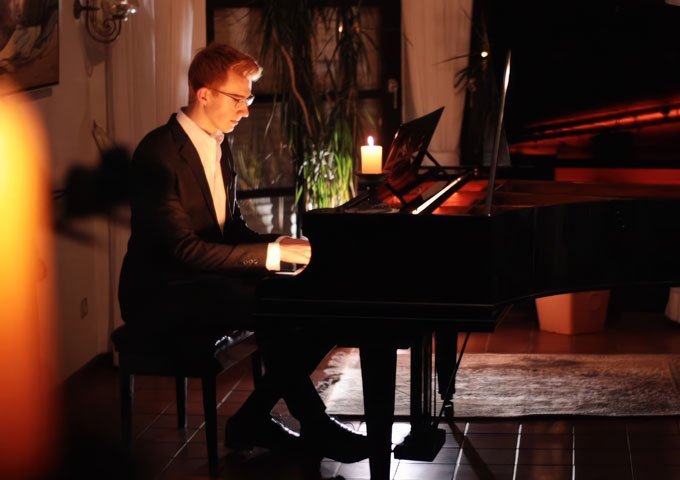Some songs aren’t written so much as released—pulled out in the moment when silence feels unbearable. Luke Assem’s new single, “Fire of a Romance,” is one of those pieces: a piano-driven ballad born less from craft and more from uncontainable emotion. It manages to feel both cinematic and deeply personal, combining confession with both acoustic and orchestral textures.
For Luke, music has never been about following rules. A computer science student who rediscovered his father’s old 1970s keyboard, he never studied formally or learned to read notation. Instead, he leaned into the possibilities of modern tools, where software can summon entire orchestras with a keystroke. To him, the absence of training has been liberating. “Music theory isn’t holding anyone back anymore,” he says. “The only thing I know is that I love creating it. It’s my therapy.”
That urgency comes through in “Fire of a Romance.” Built on elegant piano lines, rising strings, and ghostly choral layers, the track’s heartbeat is Luke himself. His voice moving from a near-whisper to anguished intensity, before softening into weary acceptance. Rather than simply telling a story, it plays out heartbreak in real time.
The song’s origin is rooted in a personal moment. One night, Luke confessed love to a close friend. Silence followed. In that pause, when connection dissolved into absence, he realized the feeling was not returned. Choosing to retreat rather than linger in pain, he turned to the piano, where grief shaped the earliest version of “Fire of a Romance.”
“This song is exactly how it felt,” he explains. “Being consumed by a fire I started but couldn’t control. It isn’t a cure or a revenge note. It’s just letting the flame burn out.”
The arrangement reflects that arc. At 0:17, his voice enters tentatively, almost afraid to disturb the quiet. By 0:36, the first chorus begins to thicken the air. At 1:48, the orchestration erupts, and by 2:16, the music cracks open into a full outcry. Then, at 2:36, it falls back into calm – the kind no one asks for but eventually must accept.
The lyrics match the music in restraint. Sparks, dust, and flares open the song, casting love as volatile and combustible. The recurring line, “This is a fire of a romance, but I am on my own,” captures the paradox of passion without reciprocity.
In the second verse, imagery of being “engulfed in the blaze” and calling out into emptiness highlights the isolation of unreturned longing. What should be shared turns into echoes of solitude. By the final act, the metaphors shift from fire to aftermath – ashes, scars, and the clarity that pain leaves behind. The line “How could I pretend that flames do not cause scars?” delivers the recognition with plain force.
The ending, “Now it is all burned down,” lands not as defeat but as release. There is no promise of rebirth, only the acceptance that comes after letting go.

The video for the track was made with the same impulsive energy. Two days before release, there was no plan, just the idea of a grand piano. After music schools refused, Luke searched for private sellers of pianos, asking if he could borrow one. Most declined, until one family agreed.
In their living room, Luke recorded at a 120-year-old Bechstein while the crew filmed. Later that night, they captured fire imagery outdoors. With less than a day before release, Luke edited the footage himself and added VFX. The final cut, completed in under 24 hours, became the visual counterpart to the song’s urgency. The process mirrored the track: both improvised, both driven by intensity, both made possible by exhaustion pushed aside in favor of expression.
What gives “Fire of a Romance” its weight isn’t polish or grandeur but honesty. Luke doesn’t conceal the wound. His voice isn’t designed for perfection – it trembles under the strain of the moment. That rawness makes the song resonate beyond his personal story. Though it comes from one experience – an unspoken confession to a friend – the feeling is familiar: watching a fire you sparked consume everything around you.
Its structure carries a cinematic quality, unfolding like a short film with exposition, tension, climax, and resolution. It could easily underscore a romance drama scene—except here, the drama is memory, and the director is loss.
Luke Assem doesn’t present himself as an expert. “I have no clue if my music is good, special, or anything else,” he admits. He writes not to impress but to cope. That instinct for survival is what makes “Fire of a Romance” pulse with life.
Luke may not have deliberately set out to make a career-defining work, but in many ways, he has. The track shows how openness, when paired with unfiltered creativity, can create something both personal and lasting.
It begins in a whisper, burns in full blaze, and ends in surrender—tracing not just the arc of a romance but the endurance of the heart. And like any fire, once seen, its light stays in the mind long after the flames are gone.
OFFICIAL LINKS: WEBSITE – SPOTIFY – YOUTUBE – DEEZER – APPLE MUSIC – AMAZON MUSIC
SOCIAL MEDIA: INSTAGRAM – TIKTOK


